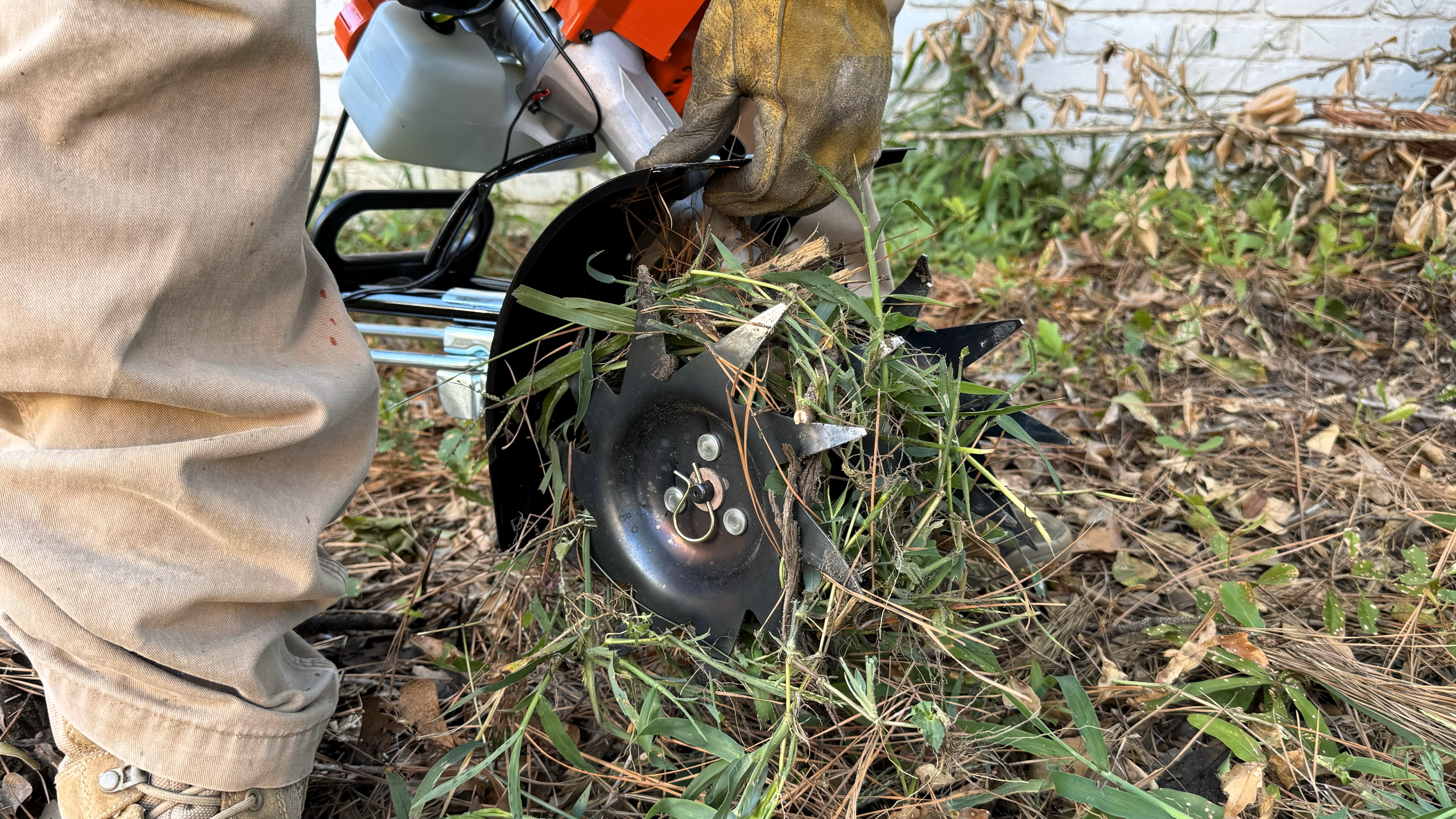Tilling can prepare the ground for grass and other plants, as well as aerate it so that nutrients can get deep into the soil. There are a few different types of tillers: front tine, mid tine and rear tine.
In this article we will be talking about front and rear tine tillers, looking at the differences in price, features, functions, performance and value. I've spoken to some industry experts to get the lowdown on these two types of tiller to help you make an informed choice before you make a purchase.
Award-winning landscape contractor and international arborist Scott Seargeant told me: "Both rear and front tine tillers cultivate the soil in preparation for planting. A front tine tiller is designed to be used on soils that have been tilled or loosen before. They are better in smaller spaces and can get into corners easier.
"Meanwhile, rear tine tillers can handle harder, moderately compacted soils. They are better suited for heavier soils, especially if there is vegetation, and can they till deeper."
Read on to find out more about the differences between these two types of tiller.
Rear tine tiller vs front tine: price & value
- Front tine tillers are slightly cheaper than rear tine ones.
- Value-wise, rear tines are best for breaking new ground, while front tines are better for existing beds.
When it comes to price, front tine tillers tend to be cheaper than rear tine ones.
Valeria Nyman, chief product officer at Taim.io, told me: "Rear tine tillers start around $600 and can shoot up past $3,000 for serious machines. Front tine tillers are more like $200 to $800.
"Don't forget that you can rent one, and if so, you’re looking at $40 to $100 a day for a rear tine, and maybe half that for a front tine. Not a lot, and you probably only need it rather rarely anyway...
Nyman says when it comes to better value, it depends on what you need the tiller for.
"If you’re breaking new ground, rear tine is worth every penny - or every bead of sweat if you rent it by the day. If you’re just fluffing up existing beds, a front tine will do fine."
Seargeant told Top Ten Reviews: "Rear tine tillers cost more than their front tine tiller counterpart and they are for tougher tilling lobs.
"Consequently, they are made with stronger parts. The price difference can be substantial depending on the model."
He adds: "I find the rear tine tiller a better value in most tilling scenarios, except small areas that have been till in the recent past."
Rear tine tiller vs front tine: Features & functions
- Rear tine tillers tend to have more features and functions.
- Front tines are less sophisticated then rear tine tillers but they are easier to maneuver in tight spaces due to their design.
- Rear tine tillers can typically dig deeper into the soil than front tine ones.
Firstly, the tine placement is different on each tiller - as you'd expect by the name, rear tine tillers have tines behind the wheels at the back, while front tine tillers have them at the front of the wheels.
Nyman says when it comes to features and functions, rear tine tillers have different tine rotations - standard, counter, or dual - that change how they chew through the soil.
"They often have self-propulsion, multiple speed settings, and nice, beefy wheels. Front tines are simpler... tines spin forward, you push, it digs. Some have adjustable tilling widths or depth controls, but they’re generally less sophisticated as far as I've seen."
Seargeant agrees with Nyman: "The front tine tillers generally have fewer features. The tines turn slower and there is no reverse direction of the tines. The tines are more exposed to objects so be careful operating them. Front tine tillers are lighter, causing them to bounce around while in operation. This can make for a long day using a front tine tiller!
"Rear tine tillers have a reverse gear in case something gets lodged in the tines and will not till. The tines are covered by a shield. Rocks and other debris can get stuck between the shield and tines causing the machine to stop tilling. Use the reverse gear should this happen. The reverse gear usually dislodges the item quickly.
"A few rear tine tillers have a reverse tilling feature that helps if you hit a hard area and need to quickly till it again."
Rear tine tiller vs front tine: Performance
- Rear tine tillers tend to be more powerful and able to navigate varous terrains.
- If soil is already loose, front tines work well.
- Rear tine tillers are better for large gardens, breaking new ground and tough soil.
- Front tine tillers are best for smaller gardens, established beds and areas needing precise control.
When it comes to performance, a rear tine tiller will power through almost anything, says Nyman, "clay, sod, that weird rocky patch you regret buying a house on... Front tine tillers bounce if the ground is too hard. But if the soil is already loose, a front tine will munch through things just fine."
Seargeant adds: "I’ve used both and rear tine tillers perform better than front tine tillers. Their heavier make-up helps them stay on course and till through tough areas instead of bouncing along the top of the ground. Rear tine tillers perform better when tilling vegetation into the soil.
"Personally, I like the rear tine tillers because they have more horsepower, are easier to use, and get the job done faster. They rarely need more than two passes, where front tine rototillers can take repeated passes to get the same results.
"The rear tine rototillers are great for larger areas and soil that have not been tilled before or are moderately compacted. I recommend applying a moderate amount of water on the soil 4 to 12 hours before tilling to help soften the soils and keep the dust to a minimum."
Rear tine tiller vs front tine: Maintenance
- Regular cleaning and maintenance will make both types of tine last longer.
When it comes to cleaning and maintenance, both tines need cleaning after each use. Seargeant told me: "Both types of tiller clean up well with a garden hose and a nozzle. The front tine tiller is easier to clean because it is lighter, and the tines are more exposed. Wipe them down to remove any stuck-on dirt and grime.
"Check the drive belt before each use. Loose or worn drive belts should be replaced. Check the oil each time you refuel the gas tank.
"Change the oil at least once a year. Check and clean the air filter before each use. Check for loose nuts and bolts, tighten as needed," advises Seargeant.
Rear tine tiller vs front tine: which is better?
Ultimately your choice of tiller will depend on your budget, yard size and what you need to do with your lawn. Don't forget you can rent tillers if you just need it for a one-off project.
"In my opinion, the rear tine tiller is better," says Seargeant. "Price is not always the best determining factor. I pay more for a rear tine tiller because it gets the job done faster and with less physical wear and tear."
Nyman told me: "If you need brute force, rear tine. If you want to tweak your beds in spring, front tine. Simple!"

Valeria Nyman is a lawn care specialist who has expertise in creating the perfect conditions to grow produce.She is also chief product officer at Taim.io, a platform that helps people grow their own food.

Scott Seargeant is an award-winning landscape contractor and international arborist. Scott is a published author, writer, an award-winning photographer and film producer.
Rear tine tiller vs front tine: FAQs
Is a rear or front tine tiller better?
You can use a front tine tiller as a stand-alone machine for established gardens. But if you have a larger yard or need to break new ground, a rear tine tiller would be more beneficial.
What is an advantage of a rear tine tiller?
Rear-tine tillers have tines behind the wheels, which makes it more powerful at tilling larger areas and harder soils. This makes them ideal for heavy-duty tasks and big yards.
When not to use a tiller?
You shouldn't use a tiller straight after planting. This is because it puts air pockets into the soil, which can affect seed germination.

